Experimental Study of the Temperature Distribution in CRTS-II Ballastless Tracks on a High-Speed Railway Bridge
Abstract
1. Introduction
2. Experimental Program
2.1. Design and Construction of the Specimen
2.2. Temperature Test Device
2.3. Determination of the Maximum Temperature Value
3. Vertical Temperature Distribution
3.1. Temperature-Time Relationship
3.2. Vertical Temperature Gradient
3.3. Vertical Temperature Distribution
3.4. Vertical Temperature Difference Distribution
4. Transverse Temperature Distribution and Laws
4.1. Transverse Temperature Distribution
4.2. Transverse Temperature Difference and Temperature Gradient
5. Three-Dimensional Temperature Distribution
6. Discussions
7. Conclusions
- (1)
- According to the EHT test and the CHT test, there is an obvious difference in the temperature conduction in the different layers of the track, and the greater the depth from the top surface of the track slab, the more obvious the temperature conduction lag.
- (2)
- In summer, the internal temperature gradient in the different of the track layers is positive and changes periodically (every 24 h). The bottom base is the less affected by the vertical temperature gradient in the track. The CA mortar layer shows heat insulation and preservation effects in the different test conditions, and is the layer the most affected by the vertical temperature gradient in the track.
- (3)
- The vertical temperature distribution in the track has a nonlinear, three-stage trend and the heat conduction in the CA mortar layer is blocked; therefore, the temperature gradient effect in the track is very significant.
- (4)
- The transverse temperature distribution in the different layers of the CRTS-II ballastless track has a quadratic parabolic trend, and the CA mortar layer is the most significant factor affecting the transverse temperature distribution in the track.
- (5)
- The CA mortar layer exhibits a heat insulation effect to reduce the heat loss. At the same time, the concrete box girder also exhibits continuous temperature preservation performance in the bottom base when the air temperature decreases.
- (6)
- In the EHT test, when the air temperature increases rapidly, the three-dimensional temperature distribution in the track has a nonlinear three-stage surface trend, and when the air temperature decreases rapidly, the three-dimensional temperature distribution in the bottom part of the track has a saddle-shaped surface trend. The distribution in the upper part has a duck-tongue surface trend. Under the no direct sunshine high temperature conditions of the CHT test, the three-dimensional temperature distribution in the track has a double hump saddle surface trend.
Author Contributions
Funding
Acknowledgments
Conflicts of Interest
References
- Zhou, L.Y.; Yang, L.Q.; Shan, Z.; Peng, X.S.; Akim, D.M. Investigation of the fatigue behaviour of a ballastless slab track-bridge structure system under train load. Appl. Sci. 2019, 9, 3625. [Google Scholar] [CrossRef]
- Ramos, Ó.R.; Schanack, F.; Ortega Carreras, G.; de Vena Retuerto, J. Bridge length limits due to track-structure interaction in continuous girder prestressed concrete bridges. Eng. Struct. 2019, 196, 109310. [Google Scholar] [CrossRef]
- Gautier, P.E. Slab track: Review of existing systems and optimization potentials including very high speed. Construction. Build. Mater. 2015, 92, 9–15. [Google Scholar] [CrossRef]
- Liu, X.Y.; Zhao, P.R.; Dai, F. Advances in design theories of high-speed railway ballastless tracks. J. Modern Transp. 2011, 19, 154–162. [Google Scholar] [CrossRef]
- Jiang, L.Q.; Ye, J.H.; Zheng, H. Collapse mechanism analysis of the FIU pedestrian bridge based on the improved structural vulnerability theory (ISVT). Eng. Fail. Anal. 2019, 104, 1064–1075. [Google Scholar] [CrossRef]
- Liu, J.; Liu, Y.J.; Zhang, G.J. Experimental analysis of temperature gradient patterns of concrete-filled steel tubular members. J. Bridge Eng. 2019, 24, 04019109. [Google Scholar] [CrossRef]
- Kim, S.H.; Cho, K.I.; Won, J.H.; Kim, J.H. A study on thermal behaviour of curved steel box girder bridges considering solar radiation. Arch. Civ. Mech. Eng. 2009, 9, 59–76. [Google Scholar] [CrossRef]
- Xia, Q.; Zhang, J.; Tian, Y.D.; Zhang, Y.F. Experimental study of thermal effects on a long-span suspension bridge. J. Bridge Eng. 2017, 22, 04017034. [Google Scholar] [CrossRef]
- Mirambell, E.; Aguado, A. Temperature and stress distributions in concrete box girder bridges. J. Struct. Eng. 1990, 116, 2388–2409. [Google Scholar] [CrossRef]
- Hagedorn, R.; Martí-Vargas, J.R.; Dang, C.N.; Hale, W.M.; Floyd, R.W. Temperature gradients in bridge concrete i-girders under heat wave. J. Bridge Eng. 2019, 24, 04019077. [Google Scholar] [CrossRef]
- Abid, S.R.; Tayşi, N.; Özakça, M. Experimental analysis of temperature gradients in concrete box-girder. Constr. Build. Mater. 2016, 106, 523–532. [Google Scholar] [CrossRef]
- Lawson, L.; Ryan, K.L.; Buckle, I.G. Bridge Temperature Profiles Revisited: Thermal analyses based on recent meteorological data from nevada. J. Bridge Eng. 2020, 25, 04019124. [Google Scholar] [CrossRef]
- Elbadry, M.M.; Ghali, A. Temperature variations in concrete bridges. J. Struct. Eng. 1983, 109, 2355–2374. [Google Scholar] [CrossRef]
- Zhu, J.S.; Meng, Q.L. Effective and fine analysis for temperature effect of bridges in natural environments. J. Bridge Eng. 2017, 22, 04017017. [Google Scholar] [CrossRef]
- Song, X.; Melhem, H.; Li, J.; Xu, Q.; Cheng, L. Effects of solar temperature gradient on long-span concrete box girder during cantilever construction. J. Bridge Eng. 2016, 21, 04015061. [Google Scholar] [CrossRef]
- Zhong, Y.L.; Gao, L.; Wang, P.; Wang, S.J. Mechanism of interfacial shear failure between CRTS-Ⅱ slab and CA mortar under temperature loading. J. Eng. Mech. 2018, 35, 230–238. (In Chinese) [Google Scholar] [CrossRef]
- Yang, R.S.; Li, J.L.; Kang, W.X.; Liu, X.Y.; Cao, S.H. Temperature characteristics analysis of the ballastless track under continuous hot weather. J. Transp. Eng. Part A Syst. 2017, 143, 04017048. [Google Scholar] [CrossRef]
- Yu, Z.W.; Xie, Y.; Tian, X.Q. Research on mechanical performance of CRTS-III plate-type ballastless track structure under temperature load based on probability statistics. Adv. Civ. Eng. 2019, 8, 1–16. [Google Scholar] [CrossRef]
- Zeng, Z.P.; Huang, Z.B.; Yin, H.T.; Meng, X.B.; Wang, W.D.; Wang, J.D. Influence of track line environment on the temperature field of a double-block ballastless track slab. Adv. Mech. Eng. 2018, 10. [Google Scholar] [CrossRef]
- Liu, X.Y.; Li, J.L.; Kang, W.X.; Liu, X.K.; Yang, R.S. Simplified calculation of temperature in concrete slab of ballastless track and influence of extreme weather. J. Southwest Jiaotong Univ. 2017, 52, 1037–1045. (In Chinese) [Google Scholar] [CrossRef]
- Li, J.; Zhao, P.R.; Wan, Z.B.; Ren, B. Experimental research and numerical analysis of temperature field on bi-block ballastless track. Chin. Sci. Technol. Sci. 2014, 44, 729–735. [Google Scholar] [CrossRef]
- Yang, R.S.; Wan, Z.B.; Liu, X.Y.; Zhang, C.W.; Zhao, R.P. Temperature field test of CRTS-I twin-block ballastless track in winter. J. Southwest Jiaotong Univ. 2015, 50, 454–460. (In Chinese) [Google Scholar] [CrossRef]
- Shan, Y.C.; Zheng, S.G.; Zhang, X.F.; Luo, W.; Mao, J.D.; Kong, D.Y. Fatigue performance of the CA mortar used in CRTS-I ballastless slab track under simulated servicing condition. Materials 2018, 11, 2259. [Google Scholar] [CrossRef] [PubMed]
- Ren, J.J.; Li, X.; Yang, R.S.; Wang, P.; Xie, P. Criteria for repairing damages of CA mortar for prefabricated framework-type slab track. Constr. Build. Mater. 2016, 110, 300–311. [Google Scholar] [CrossRef]
- Rutherford, T.; Wang, Z.J.; Shu, X.; Huang, B.S.; Clarke, D. Laboratory investigation into mechanical properties of cement emulsified asphalt mortar. Constr. Build. Mater. 2014, 65, 76–83. [Google Scholar] [CrossRef]
- Zumin, O.; Fujian, L. Analysis and prediction of the temperature field based on insitu measured temperature for CRTS-Ⅱ ballastless track. Energy Procedia 2014, 61, 1290–1293. [Google Scholar] [CrossRef]
- Cai, X.P.; Lou, B.C.; Zhong, Y.L.; Zhang, Y.R.; Hou, B.W. Arching mechanism of the slab joints in CRTS-Ⅱ slab track under high temperature conditions. Eng. Fail. Anal. 2019, 98, 95–108. [Google Scholar] [CrossRef]
- Zhao, L.; Sun, L.; Fan, T.J. Temperature field analysis of CRTS-II ballastless track slab structure on soil subgrade. Appl. Mech. Mater. 2014, 587–589, 1255–1261. [Google Scholar] [CrossRef]
- Dai, G.L.; Su, H.T.; Liu, W.S.; Yan, B. Temperature distribution of longitudinally connected ballastless track on bridge in summer. J. Cent. South Univ. Sci. Technol. 2017, 48, 1073–1080. (In Chinese) [Google Scholar] [CrossRef]
- Yan, B.; Liu, S.; Dai, G.L.; Pu, H. Vertical nonlinear temperature distribution and temperature mode of ballastless track in typical areas of China. J. Railw. Soc. 2016, 38, 81–86. (In Chinese) [Google Scholar] [CrossRef]
- Zhu, J.S.; Guo, X.D.; Meng, Q.L. Analysis of fine temperature field for bridge-track system of high-speed railway. China Railw. Sci. 2019, 40, 36–45. (In Chinese) [Google Scholar] [CrossRef]
- Lou, P.; Zhu, J.P.; Dai, G.L.; Yan, B. Experimental study on bridge-track system temperature actions for Chinese high-speed railway. Arch. Civ. Mech. Eng. 2018, 18, 451–464. [Google Scholar] [CrossRef]
- China Railway Design Code. Code for Design on Railway Bridges and Culvert; TB 10002-2017; National Railway Administration of the PRC: Beijing, China. (In Chinese)

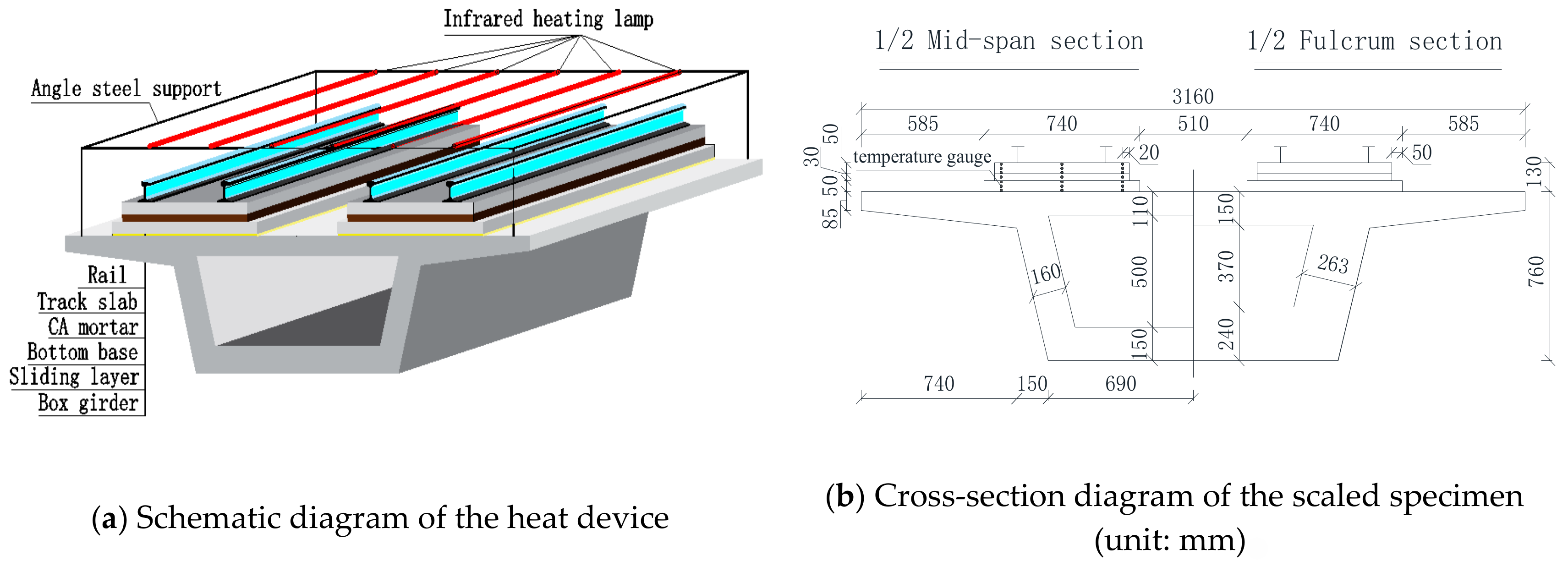
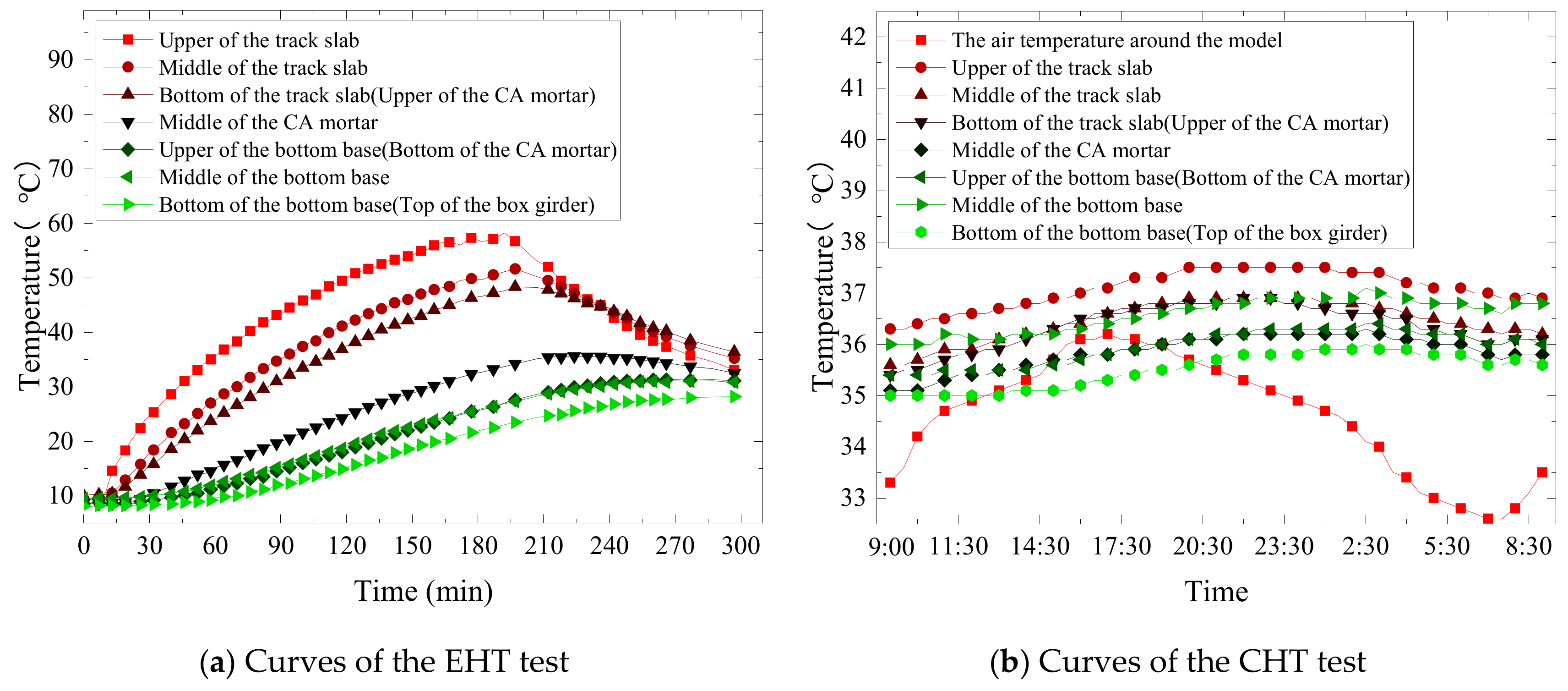
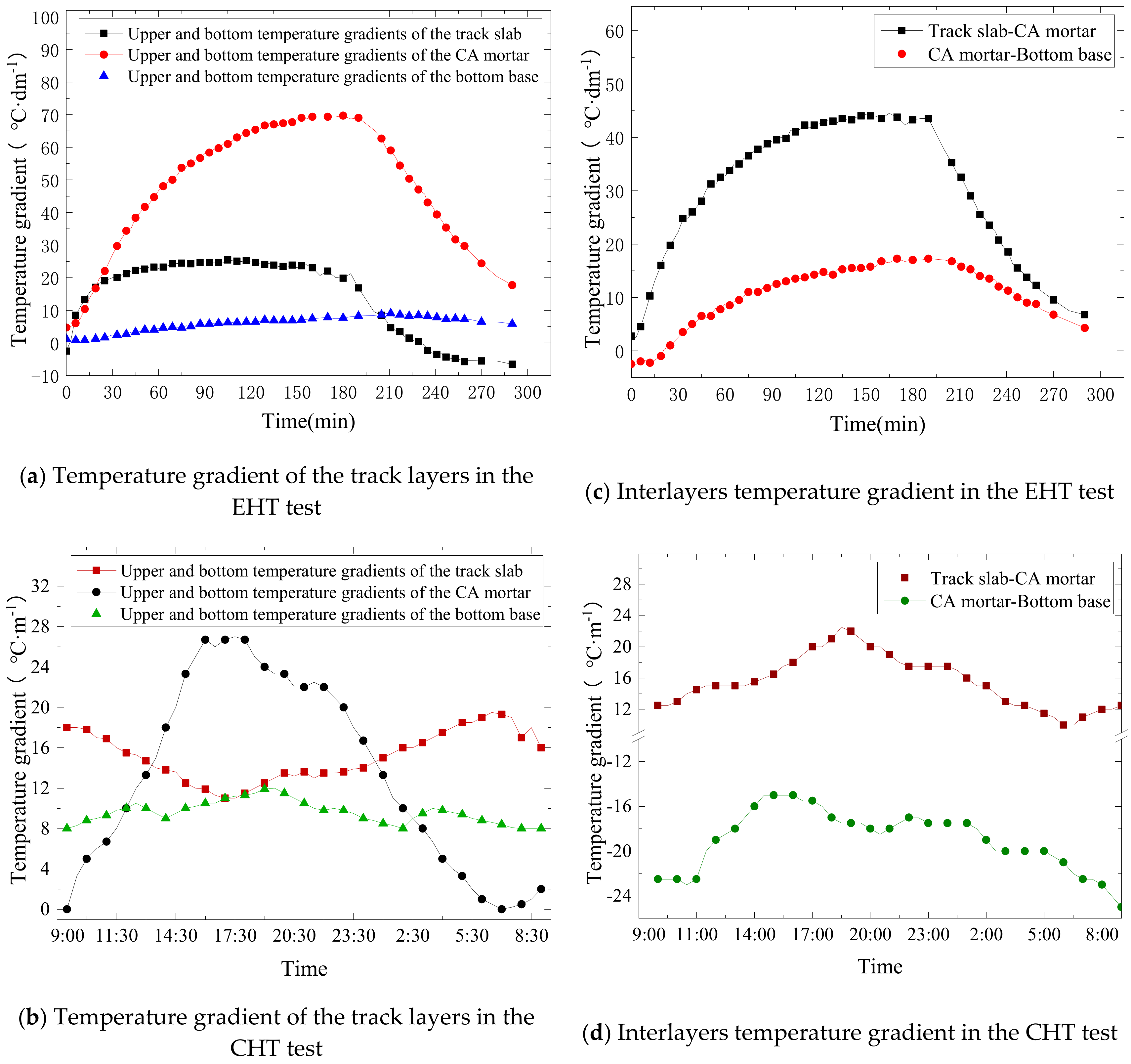
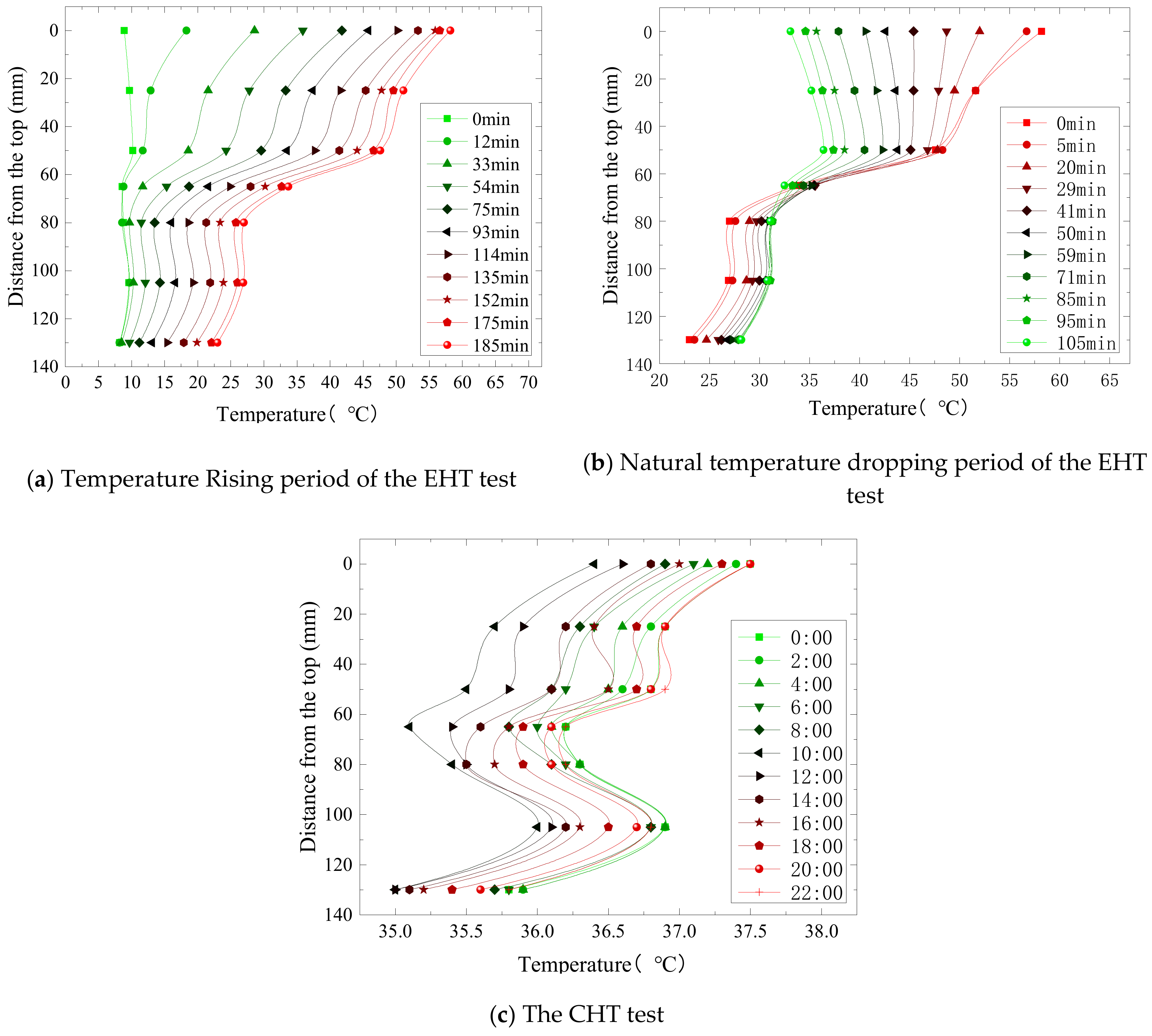
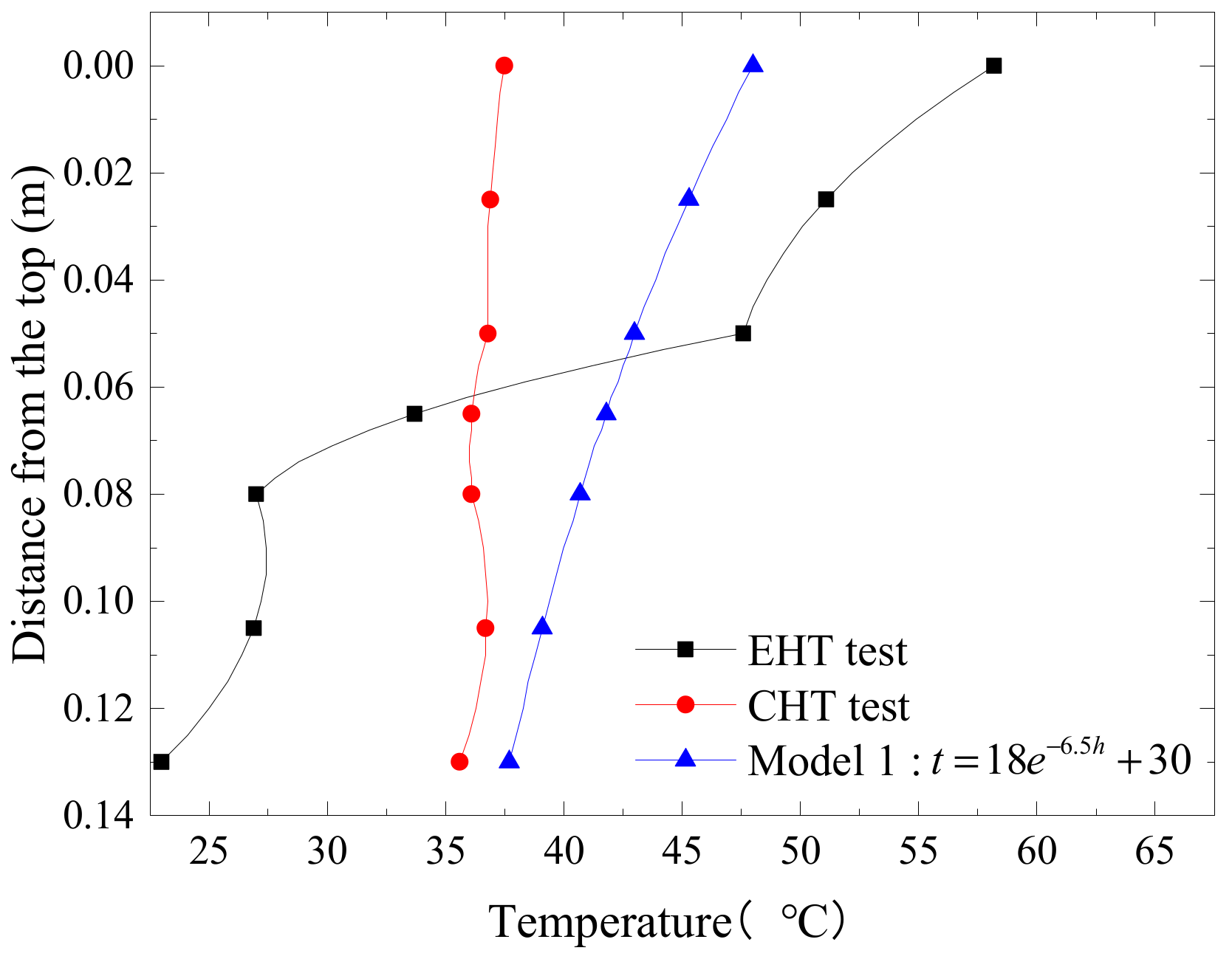
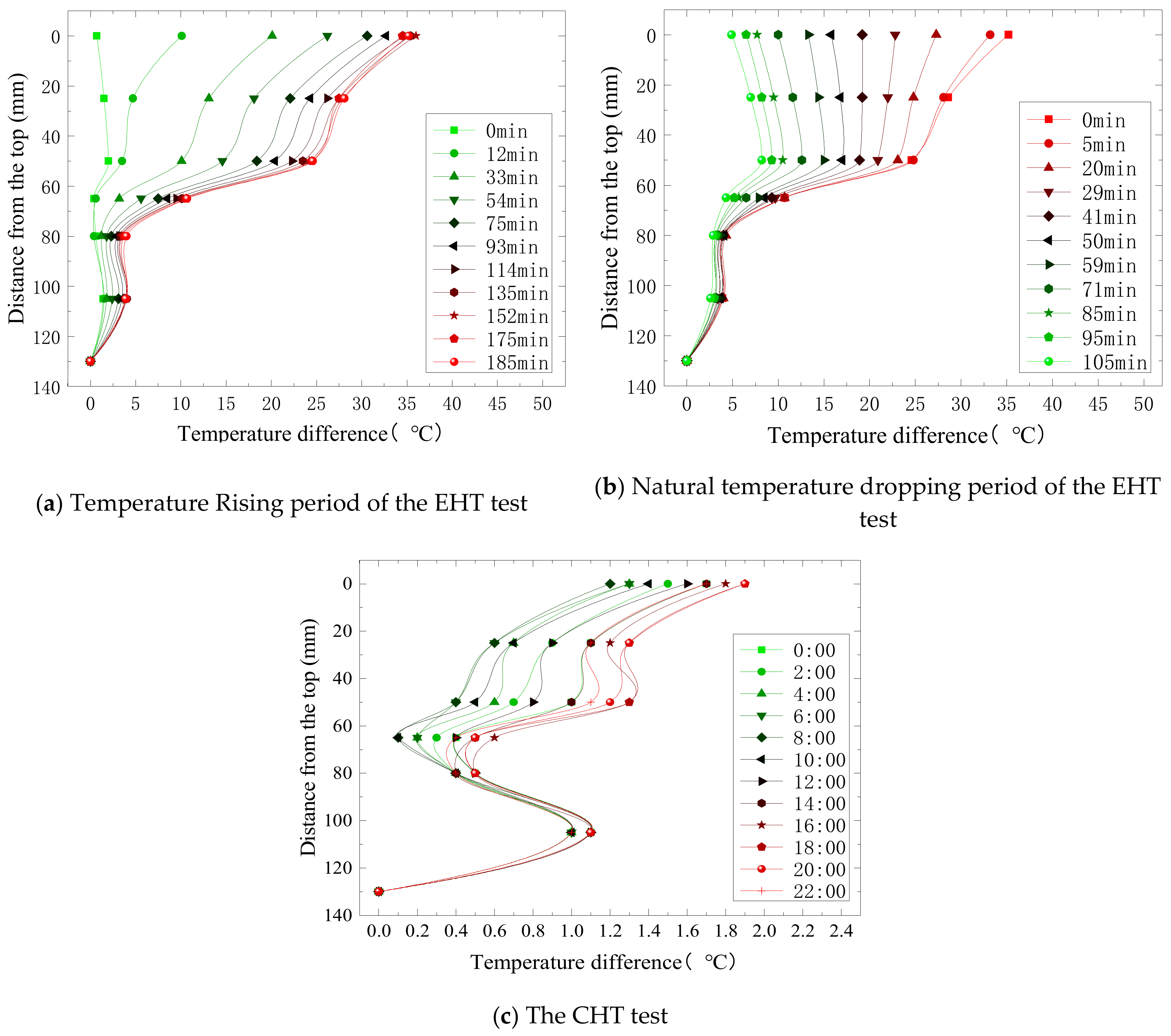
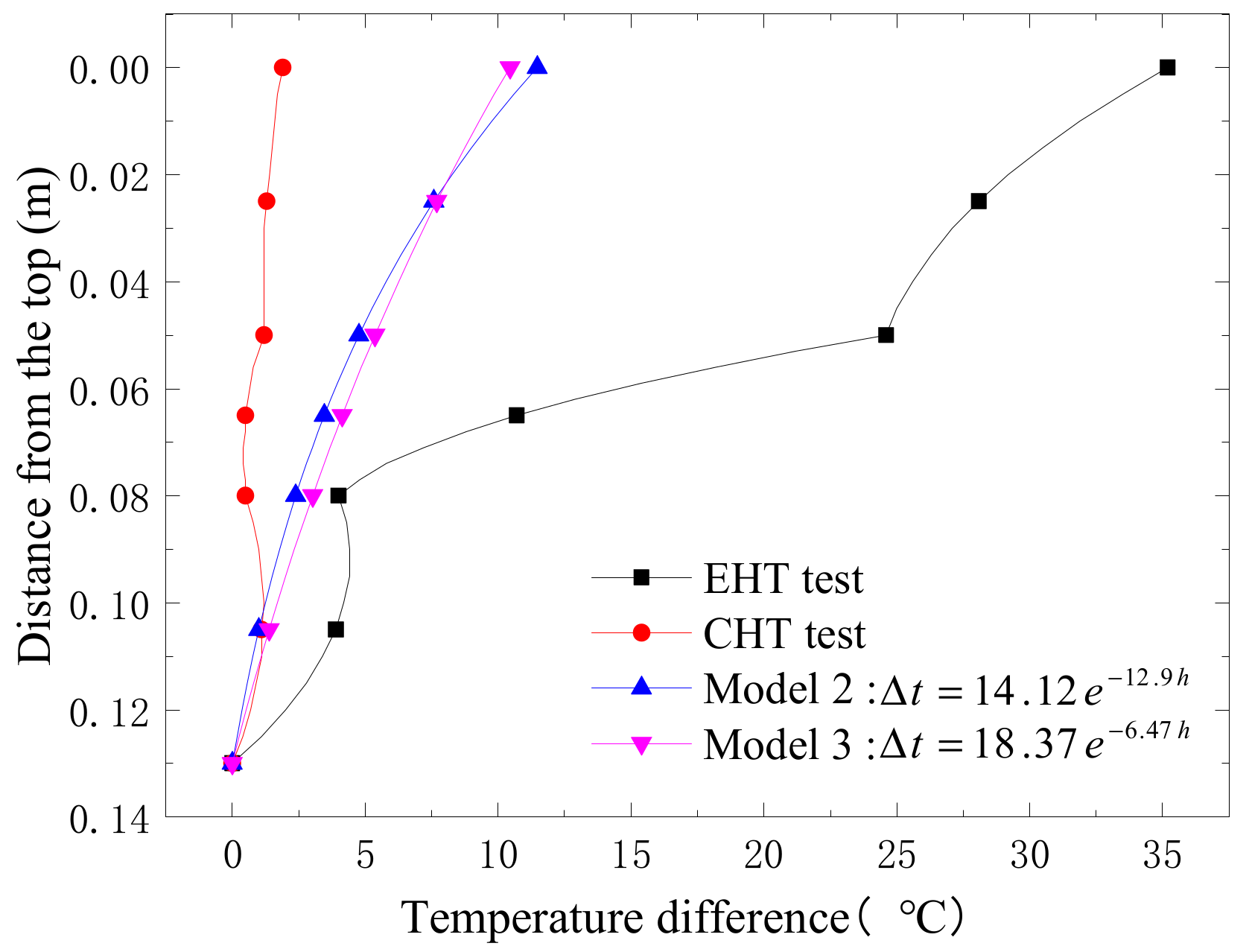
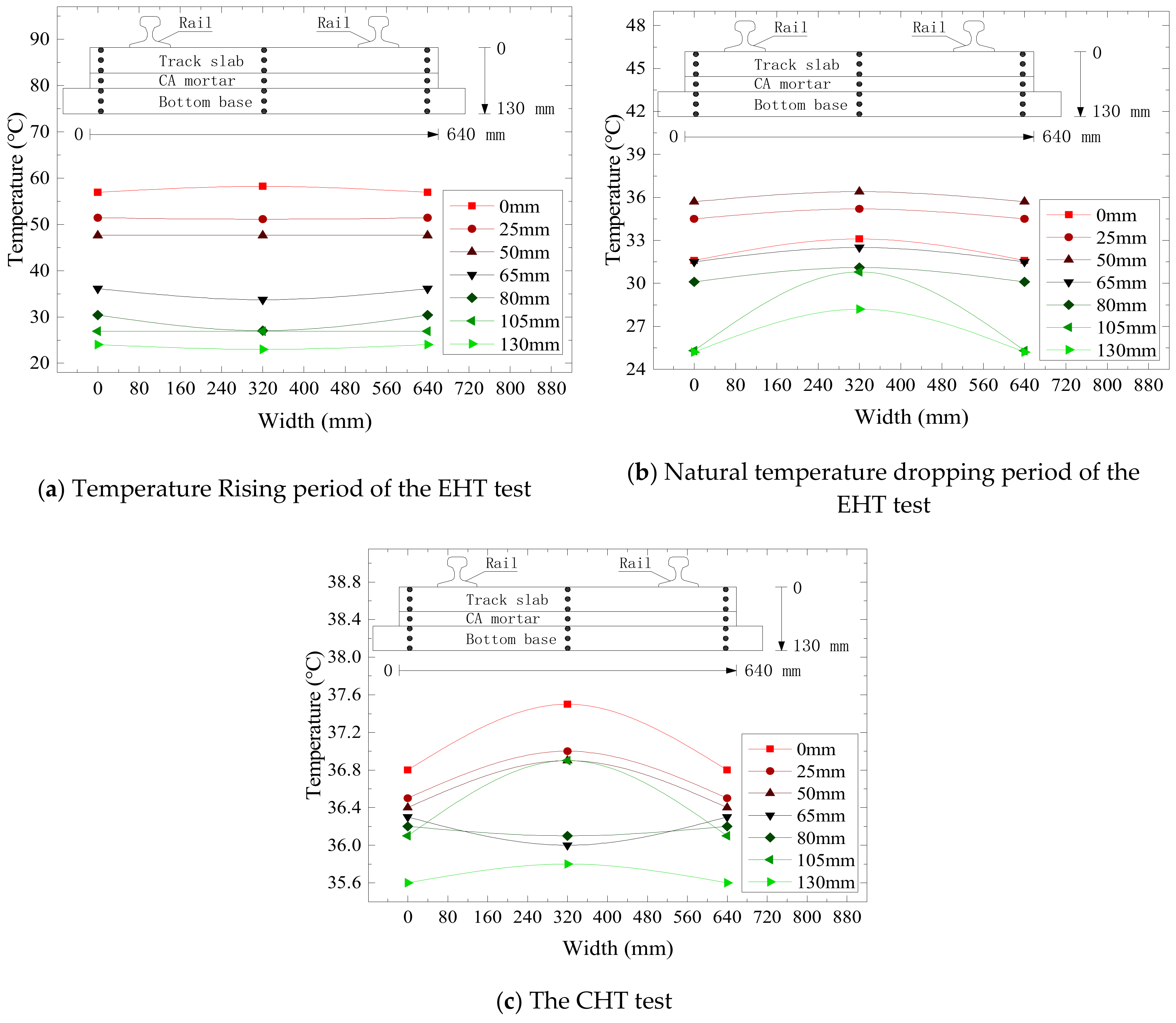
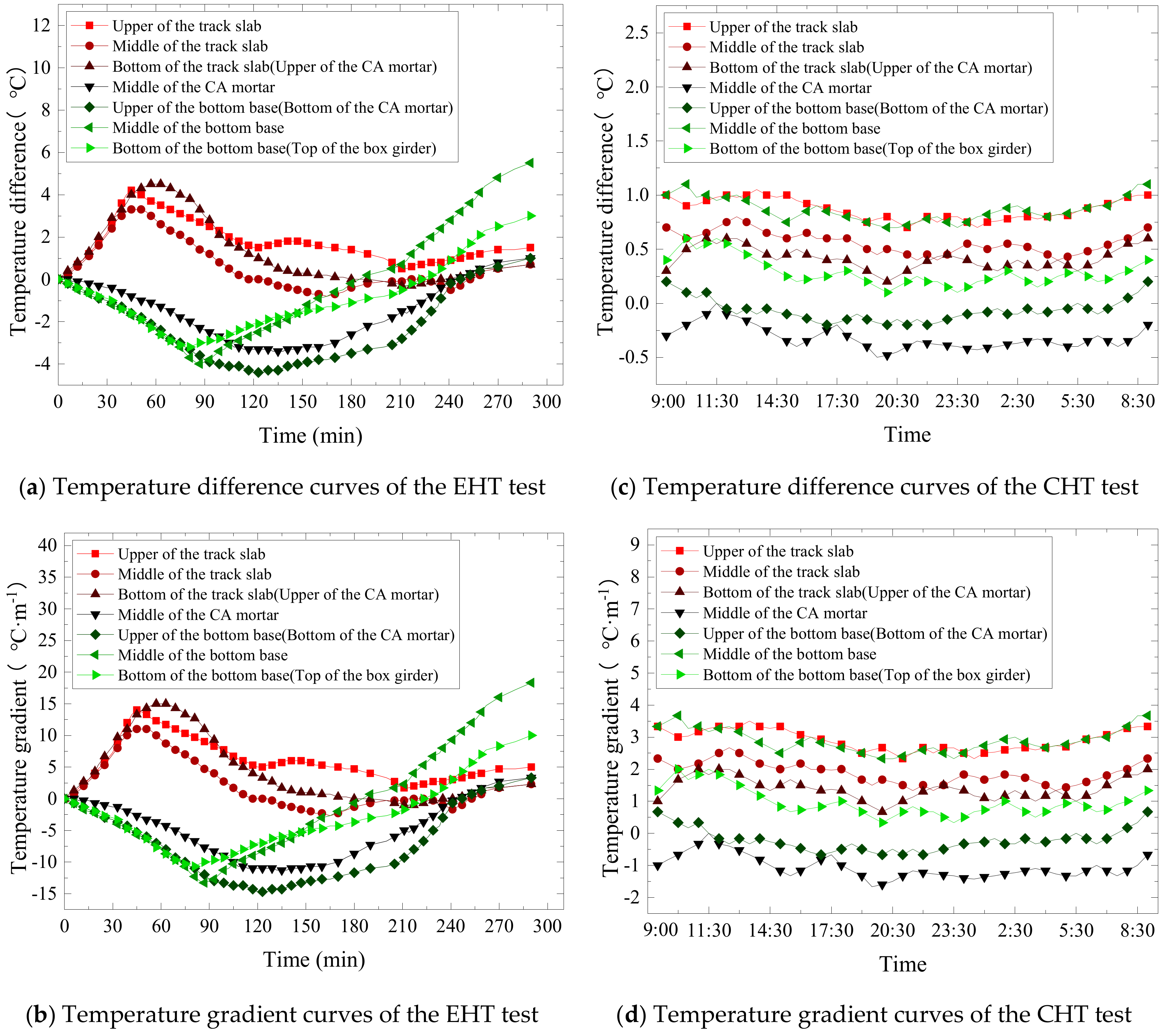
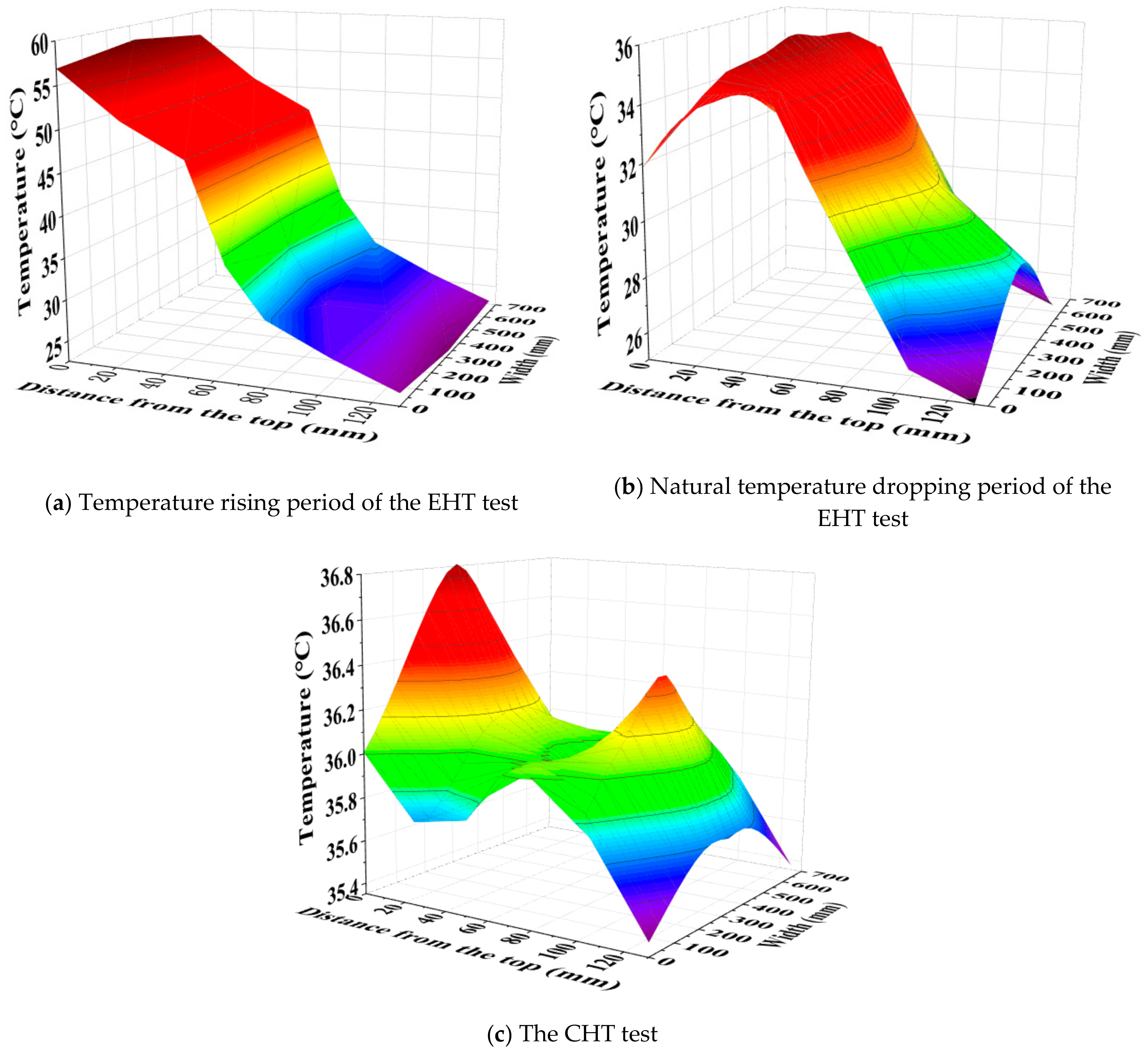
| Projects | L (mm) | S (mm2) | α (mm−1) | αs/αp |
|---|---|---|---|---|
| Scaled specimen | 900 | 88,200 | 0.0102 | 3.52 |
| Prototype | 3420 | 1,180,800 | 0.0029 |
© 2020 by the authors. Licensee MDPI, Basel, Switzerland. This article is an open access article distributed under the terms and conditions of the Creative Commons Attribution (CC BY) license (http://creativecommons.org/licenses/by/4.0/).
Share and Cite
Zhao, L.; Zhou, L.-Y.; Zhang, G.-C.; Wei, T.-Y.; Mahunon, A.D.; Jiang, L.-Q.; Zhang, Y.-Y. Experimental Study of the Temperature Distribution in CRTS-II Ballastless Tracks on a High-Speed Railway Bridge. Appl. Sci. 2020, 10, 1980. https://doi.org/10.3390/app10061980
Zhao L, Zhou L-Y, Zhang G-C, Wei T-Y, Mahunon AD, Jiang L-Q, Zhang Y-Y. Experimental Study of the Temperature Distribution in CRTS-II Ballastless Tracks on a High-Speed Railway Bridge. Applied Sciences. 2020; 10(6):1980. https://doi.org/10.3390/app10061980
Chicago/Turabian StyleZhao, Lei, Ling-Yu Zhou, Guang-Chao Zhang, Tian-Yu Wei, Akim D. Mahunon, Li-Qiang Jiang, and Ying-Ying Zhang. 2020. "Experimental Study of the Temperature Distribution in CRTS-II Ballastless Tracks on a High-Speed Railway Bridge" Applied Sciences 10, no. 6: 1980. https://doi.org/10.3390/app10061980
APA StyleZhao, L., Zhou, L.-Y., Zhang, G.-C., Wei, T.-Y., Mahunon, A. D., Jiang, L.-Q., & Zhang, Y.-Y. (2020). Experimental Study of the Temperature Distribution in CRTS-II Ballastless Tracks on a High-Speed Railway Bridge. Applied Sciences, 10(6), 1980. https://doi.org/10.3390/app10061980






